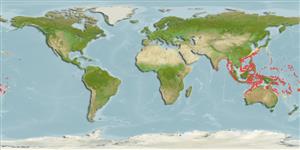Common names from other countries
>
Eupercaria/misc (Various families in series Eupercaria) >
Lutjanidae (Snappers) > Etelinae
Etymology: Etelis: Greek, etelis, -idos = a fish, perhaps the fish Sparus aurata (Ref. 45335).
Environment: milieu / climate zone / depth range / distribution range
Ecologia
marinhas demersal; intervalo de profundidade 90 - 360 m (Ref. 9821). Tropical; 35°N - 27°S, 77°E - 166°W (Ref. 55)
Indo-Pacific: Sri Lanka to Samoa, north to the Ryukyu Islands, south to Australia.
Tamanho / Peso / Idade
Maturity: Lm ? range ? - ? cm
Max length : 80.0 cm SL macho/indeterminado; (Ref. 9821); common length : 50.0 cm SL macho/indeterminado; (Ref. 9821)
Espinhos dorsais (total) : 10; Raios dorsais (total) : 11; Espinhos anais: 3; Raios anais : 8. This species is distinguished by the following characters: body relatively elongate and laterally compressed; nostrils on each side of snout close together; lower jaw protruding and premaxillae protrusible, maxilla extending to vertical near posterior margin of orbit; small conical teeth in jaws, a few anterior ones in each jaw enlarged, sometimes into canine-like teeth; with teeth on palatine and vomer, vomerine tooth patch rounded arch-shaped or chevron-shaped; maxilla with scales, without the longitudinal ridges; interorbital region flattened; gill rakers of first
gill arch 11-15 + 20-22 = 32-36 (including rudiments); continuous dorsal fin, with spinous portion deeply incised at its junction with soft portion; last soft ray of both dorsal and anal fins produced, longer than next to last ray; caudal fin lunate, with a notch at the middle of the distal margin of the fin; pectoral fins fairly long, a little shorter than head. pectoral-fin rays 16; membranes of dorsal and anal fins without scales; tubed lateral-line scales 50-51. Colour of body mainly red, lighter on lower sides and belly (Ref. 9821).
Adults inhabit rocky bottoms. Feed mainly on fishes. Marketed fresh.
Ciclo de vida ou comportamento de acasalamento
Maturities | Reprodução | Spawnings | Egg(s) | Fecundities | Larvas
Allen, G.R., 1985. FAO Species Catalogue. Vol. 6. Snappers of the world. An annotated and illustrated catalogue of lutjanid species known to date. FAO Fish. Synop. 125(6):208 p. Rome: FAO. (Ref. 55)
Status na Lista Vermelha da UICN (Ref. 130435)
CITES (Ref. 128078)
Not Evaluated
Ameaça para os humanos
Harmless
Uso pelos humanos
Pescarias: pouco comercial; peixe esportivo: sim
Ferramentas
Relatórios especiais
Baixar XML
Fontes da internet
Estimates based on models
Preferred temperature (Ref.
115969): 13.8 - 23.2, mean 19.1 (based on 215 cells).
Índice de diversidade filogenética (Ref.
82804): PD
50 = 0.5625 [Uniqueness, from 0.5 = low to 2.0 = high].
Bayesian length-weight: a=0.02042 (0.01136 - 0.03671), b=2.95 (2.80 - 3.10), in cm Total Length, based on LWR estimates for this species & (Sub)family-body (Ref.
93245).
Nível Trófico (Ref.
69278): 4.5 ±0.80 se; based on food items.
Resiliência (Ref.
120179): médio(a), tempo mínimo de duplicação da população 1,4 - 4,4 anos (Preliminary K or Fecundity.).
Fishing Vulnerability (Ref.
59153): Moderate to high vulnerability (46 of 100).
